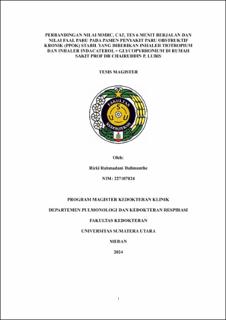Perbandingan Nilai mMRC, Cat, Tes 6 Menit Berjalan Dan Nilai Faal Paru pada Pasien Penyakit Paru Obstruktif Kronik (PPOK) Stabil yang Diberikan Inhaler Tiotropium dan Inhaler Indacaterol + Glycopyrronium di Rumah Sakit Prof Dr Chairuddin P. Lubis
Comparison of mMRC, CAT, 6 Minute Walk Test and Lung Function Values in Stable Chronic Obstructive Pulmonary Disease (COPD) Patients Given Tiotropium Inhalers and Indacaterol + Glycopyrronium Inhalers at Prof. Dr. Chairuddin P. Lubis Hospital

Date
2025Author
Dalimunthe, Rizki Rahmadani
Advisor(s)
Permatasari, Amira
Pandia, Pandiaman
Eyanoer, Putri Chairani
Metadata
Show full item recordAbstract
Background and Objectives : Chronic Obstructive Pulmonary Disease (COPD) is a chronic
disease that has a significant impact on patients' quality of life and functional capacity.
Bronchodilator inhalers such as tiotropium and indacaterol+glycopyrronium combination are used
as therapy to reduce symptoms and improve lung function in COPD patients. Comparison of the
effectiveness between these two types of inhalers in reducing symptoms and affecting lung function
and functional capacity still needs to be studied further. This study aims to analyze the comparison
of the mMRC scale, CAT score, six-minute walking test (6MWT) results, and pulmonary function
values in stable COPD patients receiving tiotropium inhalers compared to the combination of
indacaterol + glycopyrronium.
Methods: This study used a cross-sectional design with an analytic observational method. The
subjects were stable COPD patients who received tiotropium inhaler (n=54) or
indacaterol+glycopyrronium combination (n=56) at Prof dr Chairuddin P. Lubis Hospital since
September-October 2024. The mMRC, CAT, six-minute walking test (6MWT), and lung function
values (FEV1/FVC, FEV1, FVC) were observed. Statistical tests used included Wilcoxon test for
non-normally distributed data and independent t-test for normally distributed data.
Results: From the results of the study, there were no significant differences between the tiotropium
and indacaterol + glycopyrronium groups in the parameters of FEV1 / FVC, FEV1, FVC, CAT
score, and six-minute walking test results (p>0.05). Patient demographics showed balanced
characteristics between the two groups, with most patients being in the age range of 60-69 years and
having CAT scores showing mild to moderate symptoms.
Conclusion: The results of this study show that there is no significant difference in terms of
functional capacity, quality of life, and lung fauna between COPD patients receiving tiotropium
compared to the combination of indacaterol+glycopyrronium. Therefore, the selection of
bronchodilator therapy can be adjusted based on individual patient preferences and conditions
without having to maintain one option as superior.
